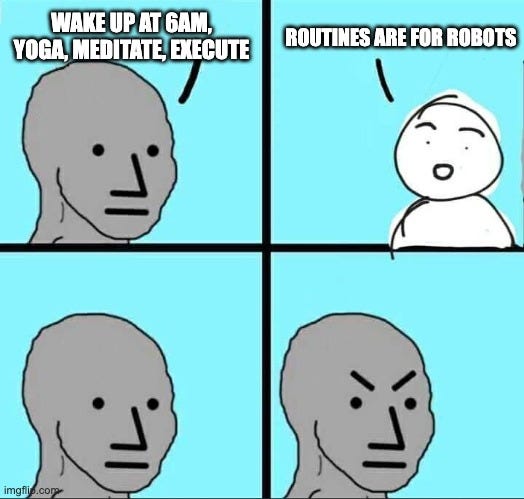The case against morning yoga, daily routines, and endless meetings

🌈 Abstract
The article discusses the concept of "10x work" - tasks that have a disproportionately high impact compared to the average work. It argues against the idea of rigid routines and checklists as the path to success, and instead advocates for embracing serendipity, taking on high-risk/high-reward projects, and focusing on developing comparative advantages.
🙋 Q&A
[01] Rejecting Routines
1. What are the key points made about routines and checklists?
- Routines and checklists are often 1x or 0.5x work - they are comfortable but add little new information or risk
- Steady routines do not lead to the high-impact "10x work" that defines careers
- The author argues against the "hustle culture" of endless tips on morning routines and productivity hacks
2. How does the author suggest breaking out of routines?
- Embrace serendipity and randomness - send outreach emails, host events, explore random topics
- Create "work assets" that compound over time, like ongoing content or decentralized communities
- Take on high-stakes projects where the outcome is uncertain but the potential upside is large
[02] 10x Work
1. What is the author's definition of "10x work"?
- 10x work refers to the small number of high-impact tasks that drive the majority of a person's professional output
- These tasks are often unpredictable, unstructured, and carry significant risk/reward
2. How does the author suggest identifying and prioritizing 10x work?
- Look at your past year's work and identify the few tasks that had the biggest impact
- Avoid getting caught up in defensive practices like calendar blocking - instead, focus on picking the right high-upside tasks to prioritize
- Develop comparative advantages in specific skills or combinations of skills to create unique value
3. What are the key characteristics of 10x work according to the author?
- Happens at the frontier of knowledge, where there is uncertainty and opportunity
- Involves injecting risk and new information into stable situations
- Requires agency and ownership, not just reacting to others
[03] The 10x Plan
1. What are the three key components of the author's "10x plan"?
- Remove/delegate/automate low-impact (<1x) work
- Continue doing 2-5x work, but align it with your overall plan
- Maximize opportunities for high-impact (10x) work through serendipity, skill development, and resource allocation
2. How does the author suggest finding time for 10x work?
- The author argues that it's not about working more hours, but about how you fill the time you have
- Focus on building comparative advantages and positioning yourself to capitalize on high-upside moments
3. What is the author's key message about achieving 10x work?
- The author emphasizes that 10x work is inherently unpredictable, but that you can create an environment where it is more likely to emerge
- The goal is to reject rigid routines and checklists in favor of embracing serendipity and taking on high-risk/high-reward projects